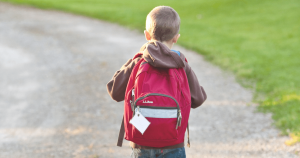6 Ways You Can Help Your Kids Stay Safe at School
Elementary school can be overwhelming, both for students and parents—even more so during a pandemic. While kids navigate classes and critical development years, parents worry about bullying, emergencies, and other scary incidents. Fortunately, there are ways you can make sure your child stays safe at school.
6 Ways you can help your kids stay safe at school

By signing up, you agree to our Terms and Conditions and Privacy Policy.
1. Stay on top of COVID-19 updates
The 2021–2022 school year is starting with lots of questions: What is the school doing to prevent the spread of COVID-19? What happens if a student in my child's class or school gets it? What will the school do if a teacher becomes ill with the virus?
Lots of parents are wondering if in-person classes will even happen, and teachers are expressing deep concern for their safety and the wellness of their students.
While we all navigate these tough decisions together, you can take action to inform yourself, prepare your child, and help teachers prepare classrooms as best as possible.
Take action
Stay informed. The CDC, states, and school districts are constantly releasing new information about going back to school. If your kids' schools will hold in-person classes this fall, take the following steps:
- Read over The American Academy of Pediatrics COVID-19 Guidance for Safe Schools for guidelines and this guide by the Cleveland Clinic to help prepare your child.
- Practice handwashing, social distancing, and proper mask-wearing together so kids are ready to do them on their own in the classroom.
- Stock up on face masks, hand sanitizer, and, if you can afford it, individual supplies for each of your children to avoid sharing germs.
- If you're able to donate supplies, ask your child's teacher what they need to stay safe this year.
- Prepare to bring kids back home if an outbreak or exposure makes it necessary.
2. Review school policies
It’s important to know how a school handles emergency situations and what rules students are expected to follow. At the beginning of every school year, review the school’s handbook with your child. This guide usually answers most parents’ questions, including those concerning dress code, the visitors policy, emergency drills and routes, and the school’s stance on bullying.
Take action
Make sure your school’s handbook answers your critical questions. If it doesn’t, contact the school’s administration office for clarification. Here are some questions to get you started:
- Is there a zero-tolerance policy for bullying?
- What how can your child prepare for a school shooting?
- What plans are in place if a natural disaster or emergency occurs?
- How often are emergency drills conducted?
- Are visitors allowed on school grounds or in the classrooms?
Check out Education World’s analysis of 10 school handbooks and what each one does well.
3. Talk regularly with teachers and administrators
The best way to stay up to date on the school’s safety policy and follow up with any safety issues is to speak with teachers and administrators on a regular basis. These conversations can shed light on any problems your child is facing. And you can do them over Zoom, email, or the phone to limit physical contact during COVID-19.
If the school doesn’t already offer parent-teacher conferences, request one with each teacher towards the middle or end of each semester and with an administrator every academic year.
Take action
When attending meetings with teachers or administrators, come prepared with a written list of questions. Here are a few examples.
- How is my child doing emotionally and socially?
- Have you witnessed any bullying or harassment in the classroom?
- Is my child present and on time to their classes?
- What can I do to help my child succeed?
- Is there something the classroom lacks that I can help supply?
- Do you conduct emergency drills in your classroom?
4. Encourage open conversation with your child
Maintaining good communication with your child helps build self-esteem and mutual respect. Focus on creating a safe environment at home that emphasizes open and honest conversation.
When you praise your child’s accomplishments and encourage emotional responses, they will be more inclined to open up about their dreams, struggles, fears, or concerns.
Take action
At least once a week, use dinnertime to ask questions about your child’s day.
- Do you know anyone who has gotten sick with COVID-19?
- Do you feel safe at school?
- What do you enjoy learning?
- Which class do you wish you didn’t have to take?
- What’s one thing you’re really good at?
- Have you witnessed any bullying at school?
- Do you feel respected by your teachers and classmates?
5. Rely on technology for assistance
As hesitant as you may be about providing your child with more technology, there are devices that keep your child safe by monitoring their social media and internet use, current physical location, and more. These devices can alert you to cyberbullying and make sure you know where your kid is at all times.
Take action
Monitor the devices your child currently uses and ensure they’re being used to best keep him or her safe. Consider following these steps:
- Create a safe space to talk to your kid about using the internet and set some ground rules. Check-in regularly.
- Use website filters to block inappropriate websites.
- Add parental control apps to your child’s phone and computer to track their online and mobile conversations for signs of depression, cyberbullying, self-harm, or online predators.
- Review kid-friendly wearable tech devices that can help you keep track of your child’s location at all times.
Why kids GPS trackers are a great alternative to a cell phone
Subscribe to our Youtube channel for more videos like this one! Learn how to protect your home, your loved ones, yourself and your belongings.
6. Confirm your child’s records are up to date
When you first enrolled your child in school, you completed endless paperwork. But as the years pass, it’s easy to forget to update their school files with pertinent information. This can be problematic if your child develops an allergy or if there’s an emergency at the school.
If your personal or contact information changes or you want to confirm what information is currently on record, communicate with the school immediately.
Take action
At least once a year or at the beginning of each semester, review and update your child’s paperwork. Consider all the critical information your child’s school should know:
- Allergies or dietary restrictions
- Medications your child takes
- Emergency contacts
- Illnesses your child may be susceptible to
- Disabilities, if any
- Approved visitors or family who can pick up your child from school
Along with these five tips, the best way to keep your child safe is to speak up. If you’re concerned about the cafeteria menu, playground bullying, or school policies, speak with administration or join the PTA.
Suggest opportunities for improvement and stay involved with school events. You’ll help your child thrive at school and contribute to creating a protected environment for all students.
Have you had success keeping your child safe at school? Comment and share your tips!
Related articles on SafeWise
Recent Articles




The post 6 Ways You Can Help Your Kids Stay Safe at School appeared first on SafeWise.
Article source here: 6 Ways You Can Help Your Kids Stay Safe at School
